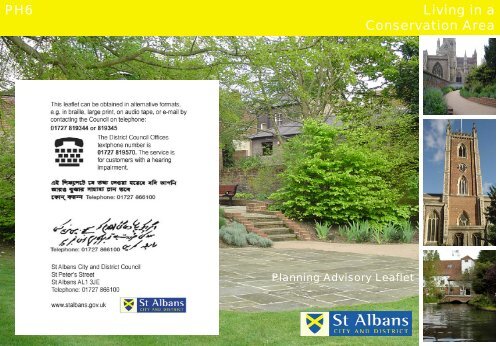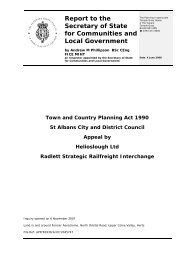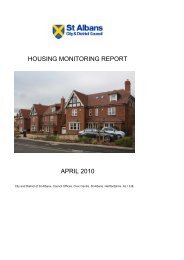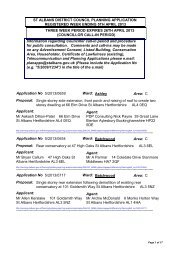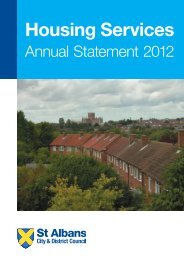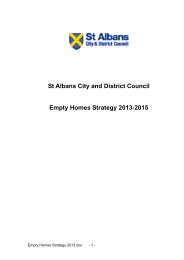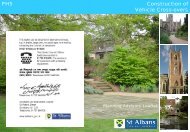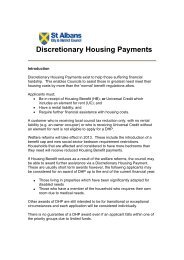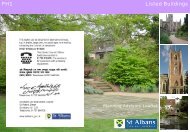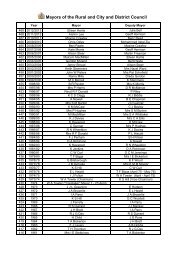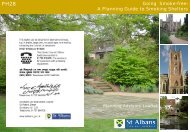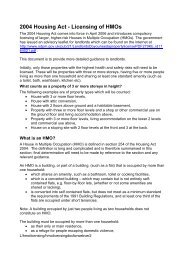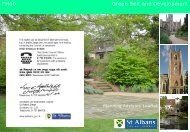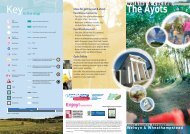Living in a Conservation Area PH6 - St Albans City & District Council
Living in a Conservation Area PH6 - St Albans City & District Council
Living in a Conservation Area PH6 - St Albans City & District Council
Create successful ePaper yourself
Turn your PDF publications into a flip-book with our unique Google optimized e-Paper software.
<strong>PH6</strong><br />
<strong>Liv<strong>in</strong>g</strong> <strong>in</strong> a<br />
<strong>Conservation</strong> <strong>Area</strong><br />
Plann<strong>in</strong>g Advisory Leaflet
LIVING IN A CONSERVATION AREA<br />
What is a conservation area?<br />
These are areas that are considered by the <strong>Council</strong> to be of ‘special<br />
architectural or historic <strong>in</strong>terest, the character or appearance of<br />
which it is desirable to preserve or enhance’.<br />
<strong>Conservation</strong> areas are aimed at protect<strong>in</strong>g the overall character<br />
created by the quality and special <strong>in</strong>terest of areas, as well as the<br />
<strong>in</strong>dividual build<strong>in</strong>gs.<br />
There are 18 conservation areas <strong>in</strong> <strong>St</strong> <strong>Albans</strong> <strong>District</strong> at present.<br />
Maps of these areas are available on the <strong>Council</strong>’s website.<br />
How do I f<strong>in</strong>d out if my house is <strong>in</strong> a conservation area?<br />
<strong>St</strong> <strong>Albans</strong> <strong>District</strong> <strong>Council</strong>’s Local Information Service (available on<br />
the website) is a map based system which conta<strong>in</strong>s this <strong>in</strong>formation.<br />
Alternatively, you can call a member of the Development<br />
Management or <strong>Conservation</strong> Team for this <strong>in</strong>formation.<br />
How are conservation areas designated?<br />
Section 69 of the Plann<strong>in</strong>g (Listed Build<strong>in</strong>gs and <strong>Conservation</strong><br />
<strong>Area</strong>s) Act 1990 imposes a duty on local plann<strong>in</strong>g authorities to<br />
designate conservation areas. The <strong>Council</strong>, as the Local Plann<strong>in</strong>g<br />
Authority, is under a cont<strong>in</strong>uous duty to consider if it should<br />
designate new conservation areas, or extend exist<strong>in</strong>g ones. The<br />
<strong>Council</strong> can also remove the designation of an area or part of an<br />
area if it loses its special <strong>in</strong>terest.<br />
When consider<strong>in</strong>g the designation of a conservation area the<br />
<strong>Council</strong> will take <strong>in</strong>to account the factors that create special<br />
character with<strong>in</strong> an historic area, for example historic build<strong>in</strong>gs,<br />
historic street patterns, layout of property boundaries and<br />
thoroughfares; characteristic materials; landscap<strong>in</strong>g and important<br />
open spaces; the quality of advertisements, shop fronts, street<br />
furniture and landscap<strong>in</strong>g; views along streets and between<br />
build<strong>in</strong>gs; and details that provide ‘local’ character.<br />
1
The first stage <strong>in</strong> the designation of a conservation area will usually<br />
be an appraisal of the area to determ<strong>in</strong>e its special architectural or<br />
historic character and to assess its worth<strong>in</strong>ess as a conservation<br />
area. A public consultation exercise may be carried out to<br />
determ<strong>in</strong>e the views of the people who live <strong>in</strong> that area. This<br />
appraisal report will then be considered by the Portfolio Holder, and<br />
a decision made as to whether or not the area should be<br />
designated. Once an area has been designated, a public notice<br />
describ<strong>in</strong>g the boundary will be published <strong>in</strong> at least one local<br />
newspaper and <strong>in</strong> the London Gazette. The <strong>Council</strong> must also notify<br />
the Secretary of <strong>St</strong>ate for Culture, Media and Sport, and English<br />
Heritage.<br />
What are locally listed build<strong>in</strong>gs?<br />
In addition to statutorily listed build<strong>in</strong>gs (see the <strong>Council</strong>’s advisory<br />
leaflet, Listed Build<strong>in</strong>gs), there are a number of valuable 18th, 19th<br />
and 20th century build<strong>in</strong>gs which are considered to be of some<br />
architectural or historic importance, and which positively contribute<br />
to the character of the conservation area, but are not on the<br />
statutory list. Although often of more modest quality, they have<br />
nevertheless become an important part of the familiar scene and<br />
help to illustrate the social, historic and architectural development of<br />
the area. Many conta<strong>in</strong> architectural features and details that are<br />
unlikely to be repeated <strong>in</strong> modern build<strong>in</strong>gs. These build<strong>in</strong>gs will<br />
normally be identified dur<strong>in</strong>g the <strong>in</strong>itial conservation area appraisal<br />
or later dur<strong>in</strong>g a more detailed study, and will be considered and<br />
agreed by the Portfolio Holder.<br />
Proposals to demolish such build<strong>in</strong>gs, or that <strong>in</strong>volve unsympathetic<br />
alterations <strong>in</strong>clud<strong>in</strong>g the loss of valuable features, are unlikely to<br />
receive consent.<br />
How do I f<strong>in</strong>d out if my house is locally listed?<br />
<strong>St</strong> <strong>Albans</strong> <strong>District</strong> <strong>Council</strong>’s Local Information Service (available on<br />
the website) is a map based system which conta<strong>in</strong>s this <strong>in</strong>formation.<br />
Alternatively, you can call a member of the Development<br />
Management or <strong>Conservation</strong> Team for this <strong>in</strong>formation.<br />
2
How am I affected as a homeowner <strong>in</strong> a conservation<br />
area?<br />
Some m<strong>in</strong>or alterations to residential properties and the erection of<br />
some outbuild<strong>in</strong>gs can normally be carried out without plann<strong>in</strong>g<br />
permission from the <strong>Council</strong>. This development is called residential<br />
‘permitted development’. The designation of a conservation area<br />
<strong>in</strong>troduces extra restrictions to ‘permitted development’. The<br />
<strong>Council</strong>’s Development Management Team can provide more<br />
<strong>in</strong>formation about whether works require plann<strong>in</strong>g or fall under<br />
permitted development.<br />
Most demolition work requires <strong>Conservation</strong> <strong>Area</strong> Consent and it is<br />
advisable to check with the <strong>Council</strong>’s Development Management<br />
Team before carry<strong>in</strong>g out any demolition <strong>in</strong> a conservation area.<br />
Where the <strong>Council</strong> has not yet produced a ‘local list’ of build<strong>in</strong>gs for<br />
a particular conservation area, the <strong>Council</strong> will have to consider<br />
whether or not a particular build<strong>in</strong>g makes a positive contribution to<br />
the conservation area as part of the consideration of an application.<br />
If it does contribute, it will be treated <strong>in</strong> the same way as a locally<br />
listed build<strong>in</strong>g.<br />
What can I do to protect the conservation area?<br />
Estate agents now agree that where orig<strong>in</strong>al features like w<strong>in</strong>dows<br />
and doors are reta<strong>in</strong>ed, houses will hold their value to a much<br />
greater extent, and that unsympathetic alterations can reduce the<br />
value of your property. Therefore, whether or not plann<strong>in</strong>g<br />
permission is required, it is important to avoid unsympathetic<br />
alterations that can be damag<strong>in</strong>g to the historic street scene, such<br />
as unsuitably designed replacement w<strong>in</strong>dows. The leaflet,<br />
<strong>Conservation</strong> <strong>Area</strong>s, a Householder’s Guide (available from the<br />
<strong>Council</strong>) sets out best practice for ma<strong>in</strong>ta<strong>in</strong><strong>in</strong>g the character of your<br />
house.<br />
What is an Article 4 Direction?<br />
With<strong>in</strong> certa<strong>in</strong> parts of a conservation area an ‘Article 4 Direction’<br />
may also exist. The aim of an ‘Article 4 Direction’ is to reta<strong>in</strong> or<br />
encourage re<strong>in</strong>statement of historically correct features of the<br />
3
street. They are designed to protect particularly vulnerable parts of<br />
conservation areas from potentially harmful alterations. With<strong>in</strong> these<br />
areas most types of ‘permitted development’ rights are withdrawn,<br />
so that nearly all types of development and external alterations<br />
need plann<strong>in</strong>g permission. Please check with the <strong>Council</strong>’s<br />
Development Management or <strong>Conservation</strong> and Design Team;<br />
leaflets on the <strong>St</strong> <strong>Albans</strong> Article 4 Direction areas are also available<br />
from the Customer Service Centre or the <strong>Council</strong>’s website.<br />
Trees<br />
Trees have legal protection <strong>in</strong> conservation areas. This means<br />
before you top, lop, fell or uproot any trees over 75mm <strong>in</strong> diameter,<br />
you must give the <strong>Council</strong>’s Trees and Woodlands Officer at least<br />
six weeks’ written notice.<br />
Apply<strong>in</strong>g for consent to develop <strong>in</strong> a conservation area<br />
A designated conservation area does not mean that all changes will<br />
be prevented; it simply means that the <strong>Council</strong> must, and will, pay<br />
special regard to whether the proposed change will ‘preserve or<br />
enhance’ the character or appearance of a conservation area. Most<br />
applications <strong>in</strong> a conservation area should be accompanied by the<br />
follow<strong>in</strong>g:<br />
a plan with the application build<strong>in</strong>g or site outl<strong>in</strong>ed <strong>in</strong> red;<br />
fully detailed and clearly labelled exist<strong>in</strong>g and proposed scaled<br />
draw<strong>in</strong>gs of all affected external elevations<br />
a design and access statement<br />
How long does it take?<br />
Applications for development affect<strong>in</strong>g conservation areas must<br />
normally be advertised <strong>in</strong> the local paper and a site notice will also<br />
normally be put up. As a rule, the decision will be given with<strong>in</strong> eight<br />
weeks. For this to be done, it is essential that that the necessary<br />
<strong>in</strong>formation is supplied with the application to avoid delay. Should<br />
your application be refused, you are entitled to appeal. However, it<br />
is advisable to discuss proposals with the Officer who dealt with<br />
your application, because you may <strong>in</strong>stead be advised to submit a<br />
revised proposal that would be acceptable.<br />
4<br />
Other sources of <strong>in</strong>formation<br />
National Plann<strong>in</strong>g Policy Framework, March 2012<br />
<strong>St</strong> <strong>Albans</strong> <strong>District</strong> Plan Review 1994, <strong>St</strong> <strong>Albans</strong> <strong>City</strong> and <strong>District</strong><br />
<strong>Council</strong><br />
<strong>Conservation</strong> <strong>Area</strong> Character <strong>St</strong>atements, <strong>St</strong> <strong>Albans</strong> <strong>City</strong> and<br />
<strong>District</strong> <strong>Council</strong><br />
The Victorian Society The Twentieth Century Society<br />
1 Priory Gardens 70 Cowcross <strong>St</strong>reet<br />
Bedford Park<br />
London EC1 M6BP<br />
London W4 1TT Tel: 0207 250 3857<br />
Tel: 0208 994 1019<br />
The Georgian Group SPAB<br />
The Georgian Group<br />
6 Fitzroy Square<br />
London W1T 5DX<br />
Tel: 020 7529 8920<br />
Further <strong>in</strong>formation<br />
37 Spital Square<br />
London<br />
E1 6DY<br />
Tel: 020 7377 1644<br />
This advisory leaflet is <strong>in</strong>tended to be a helpful and useful source of<br />
<strong>in</strong>formation and not b<strong>in</strong>d<strong>in</strong>g on any party. The <strong>Council</strong> offers no<br />
guarantee or warranties concern<strong>in</strong>g the accuracy of the <strong>in</strong>formation<br />
supplied.<br />
For more <strong>in</strong>formation about the contents of this leaflet contact:<br />
The Plann<strong>in</strong>g Department<br />
<strong>St</strong> <strong>Albans</strong> <strong>City</strong> and <strong>District</strong> <strong>Council</strong><br />
<strong>St</strong> Peter’s <strong>St</strong>reet<br />
<strong>St</strong> <strong>Albans</strong>, Hertfordshire AL1 3JE<br />
Telephone: 01727 866100<br />
Email: plann<strong>in</strong>g@stalbans.gov.uk<br />
Website: www.stalbans.gov.uk<br />
Produced by <strong>St</strong> <strong>Albans</strong> <strong>City</strong> and <strong>District</strong> <strong>Council</strong><br />
Revised May 2012. <strong>PH6</strong>(b)<br />
5


